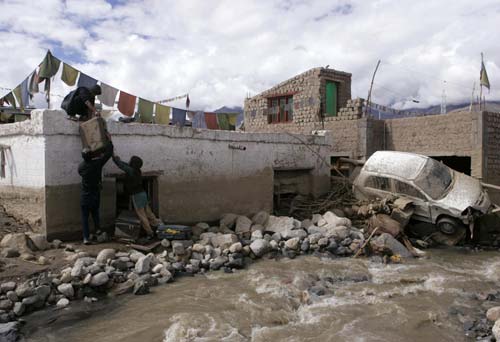Floods kill 136 in India, 500 missing
The rescue teams of Indian army Sunday intensified their operations to trace the missing underneath the debris of damaged buildings and collapsed houses, after sudden downpour and cloud burst Friday triggered flash floods and mudslides in the mountainous Ladakh in India-controlled Kashmir, officials said.
 |
|
Flash flood victims retrieve their belongings from their partially damaged house in Leh, about 443 km (275 miles) east of Srinagar August 8, 2010. [Photo/Agencies] |
While the death toll stood at 136 so far, around 500 people are reported to be still missing and another 500 injured in the natural calamity have been hospitalized.
Hundreds of Indian army personnel, paramilitary troopers, policemen and local volunteers are toiling hard to clear roads and searching underneath the debris. Locals said the rescue workers are falling short of bulldozers and earth moving equipment in the area.
Indian army has sent several columns of its troops to the affected areas to carry out rescue operations. It has also flown the relief material and doctors Saturday to the area to tackle the situation.
"The injured are being treated at makeshift medical camps and seriously injured have been admitted in army hospital Leh," said Lt. Col. J. S. Brar, the Indian army spokesman
The Indian army has a large presence in Ladakh area, bordering China.
Officials said many villages are still inaccessible, for the flash floods and mudslides have swept the road links. The Army has also pressed in the dogs to search the debris.
The telecommunication links to the area are not functioning, for the storm toppled the telecommunication towers and water inundated the telephone exchange rendering it insignificant.
Ladakh is a famous tourist destination and officials said many tourists were holidaying in the area when it was hit. So far there is no news about death of any foreign tourist in the flash floods. However, the Indian Ministry of Defense in a statement issued Friday late evening said some foreign tourists have been affected by the flash floods.
"We rescued some 100 foreign tourists who were stranded on roads. We have taken them to our camps and are taking care of them. We have not done any documentation as of now but yes there are reports that foreign tourists have got affected in this calamity," Brar said.
Authorities are trying to arrange special flights to fly the stranded tourists out of Leh.
Disaster Management officials said they are trying to get the details of deceased persons in this calamity for the information of public.
"We are trying hard to get the details of the dead to end the anxiety of the people," said Amir Ali, a disaster management official with government.
Indian defense officials said 30 army personnel are reported missing and bodies of four troopers have been retrieved. The High Altitude Research Institute of Indian army was also damaged.
The strong water current has also torn parts of the main Srinagar-Leh road and Leh-Manali road connecting Ladakh to outside world.
Trucks carrying fuel and ration are stranded at many places on way to Leh, for strong water current has swept bridges and tracts of road at many places.
Five villages are reported to be hit in the sudden downpour and flash floods. These included Sabu, Phyang, Nimoo, Choglumsar and Shapoo. Old Leh city is among the worst affected.
Ladakh is a high-altitude desert about 3,500 meters above sea level, and rainfall receives low rainfall.
Kashmir has a rugged terrain and landslides and avalanches are often triggered from its mountains during frequent rains and heavy snow the region receives.
The neighboring Pakistan has also suffered the worst flooding in 80 years. Around 14 million people were affected with the floods and 1,600 are reported dead.
 0
0 






